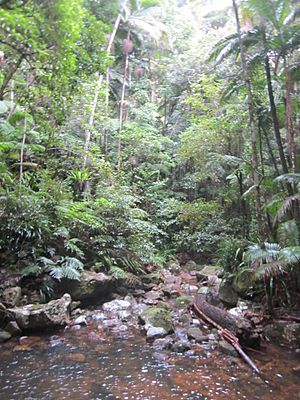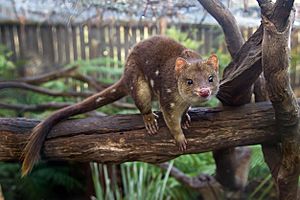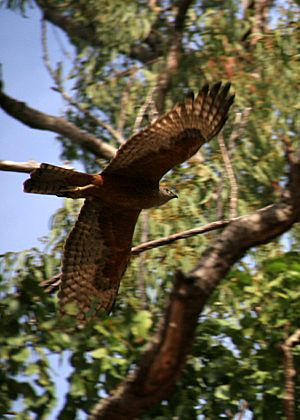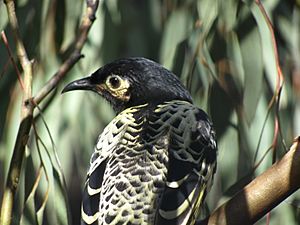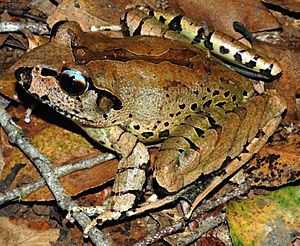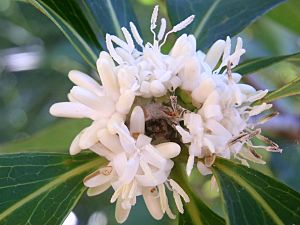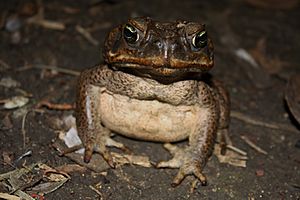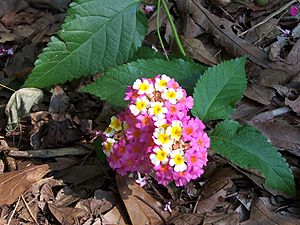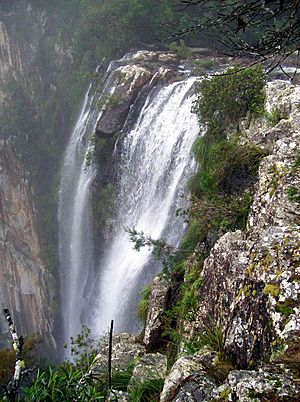Nightcap National Park facts for kids
Quick facts for kids Nightcap National ParkNew South Wales |
|
|---|---|
|
IUCN Category II (National Park)
|
|

Protesters Falls, Terania Creek, Nightcap National Park
|
|
| Nearest town or city | Lismore |
| Established | 22 April 1983 |
| Area | 81 km2 (31.3 sq mi) |
| Managing authorities | NSW National Parks & Wildlife Service |
| Website | Nightcap National Park |
| See also | Protected areas of New South Wales |
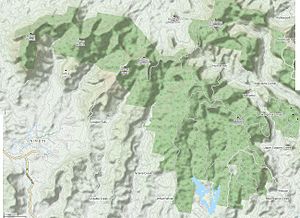
The Nightcap National Park is a special protected area in New South Wales, Australia. It's located in the Northern Rivers region, within the beautiful Nightcap Range. This park covers about 8,080 hectares (that's about 20,000 acres!). It was created in April 1983 and is about 35 kilometers north of Lismore.
Nightcap National Park is part of the amazing World Heritage Site called the Gondwana Rainforests of Australia. This means it's recognized globally for its unique and ancient rainforests. These forests are super old, with links back to the supercontinent Gondwana. The park faced big challenges during the 2019-2020 Australian bushfire season. These fires sadly affected its plants and animals.
Contents
The Land and Weather of Nightcap Park
How the Land Was Formed
Nightcap National Park sits on the edge of an ancient, eroded volcano called Mount Warning. Millions of years ago, this volcano erupted. Over time, wind and rain wore it down. This created the cool gullies, ridges, and peaks you see today. The tallest point in the park is Mount Burrell, also known as Blue Knob. It stands 933 meters above sea level.
Rainforests and Soil Types
The lava that flowed from the Tweed volcano over 23 million years ago created different types of soil. This is why the park has various kinds of rainforests.
- Where the soil is rich in nutrients from basalt lava, you'll find lush sub-tropical rainforests.
- On soil with a rhyolite base, there are warm temperate rainforests.
Nightcap's Wet Weather
Nightcap National Park gets the most rain in New South Wales. It can receive over 2,500 millimeters of rain each year! The average temperature is usually between 19.1°C and 29.7°C. It can also be very humid, and sometimes temperatures can reach almost 40°C. During summer, strong storms and even cyclone-like weather can happen.
Aboriginal History and Culture
Many Aboriginal communities have lived in the Nightcap region for thousands of years. They have a deep spiritual connection to this land. The Widjabal people, for example, have lived here for at least 4,000 years. The area is also important to the Bundjalung people.
The park's landscapes, plants, and animals are very important in Aboriginal culture. They feature in many dreaming stories. There are also sacred sites in the area that hold great cultural meaning. The park provided rock shelters for Aboriginal people in the past.
The Story of Nightcap National Park
Early Tracks and Telegraph Lines
Before it became a national park, the area was an important link between the Richmond and Tweed valleys. This link was called the Historic Nightcap Track. In 1871, it became the first horse track. By 1874, a telegraph line was built along it. Today, part of this old track is a walking trail in the park.
Protecting the Rainforests
The modern movement to protect nature in this region started in the 1970s. People wanted to stop logging (cutting down trees) in the rainforests. Terania Creek, inside Nightcap, was where the first big protests against rainforest logging in Australia happened.
By 1979, these protests grew stronger. This time was even called the "Rainforest War." Many dedicated activists worked to protect the forests. They had support from the Premier of New South Wales, Neville Wran. People risked their lives because they felt such a strong connection to these amazing trees.
Becoming a National Park
Nightcap officially became a national park in 1983. Later that year, more areas were added to it. In 1989, UNESCO gave world heritage protection to many reserves, including the western part of Nightcap. This area is now known as the Gondwana Rainforests of Australia. It protects unique subtropical rainforests with amazing plants and animals. It also has special landforms that show links to the ancient supercontinent Gondwana.
Important Bird Area
In 2009, a group called BirdLife International named the Nightcap Range an "Important Bird and Biodiversity Area" (IBA). This means it's a crucial place for birds and other living things. The Nightcap Range IBA includes Nightcap National Park and other nearby parks. It's known for special birds like:
- Albert's lyrebird
- Green catbird
- Pale-yellow robin
- Australian logrunner
- Paradise riflebird
- Regent bowerbird
Amazing Plants and Animals
Nightcap National Park is home to a huge variety of plants and animals. About 70% of the park is covered by different types of rainforests. The rest is mostly wet and dry sclerophyll forests. The park also protects lowland species from the "Big Scrub," which was once a massive rainforest that was mostly cleared. Less than 1% of it remains today.
About 10% of all known native plants in New South Wales can be found here. 72 of these plants are in danger of disappearing forever. The park is a home for:
- Over 40 types of mammals
- 27 types of reptiles
- 23 types of frogs
- Over 140 types of birds
- Over 650 known plant species, including many ferns and orchids
- Many different types of fungi and lichens
In 2011, the "Forests of East Australia" became the 35th "Biodiversity Hotspot." Nightcap National Park is part of this. A Biodiversity Hotspot is a place with many unique species that are losing their homes very quickly.
Threatened Plants and Animals
Many species in Nightcap National Park are threatened, meaning they are at risk of extinction.
Mammals at Risk
- Spotted-tailed quoll: This is an endangered meat-eating marsupial. It's the largest of its kind and has white spots on its tail.
- Koala: These famous marsupials are listed as vulnerable.
- Parma wallaby: This small, shy wallaby was once thought to be extinct. It's active at night and is now vulnerable in NSW.
- Yellow-bellied glider: This glider is often found in old, wet forests and is vulnerable.
- Rufous bettong: This marsupial has seen its numbers drop a lot since Europeans arrived.
- Long-nosed potoroo and Red-legged pademelon are also listed as threatened.
Bats in Danger
Many types of bats live in the park, and several are threatened. These include:
- Greater broad-nosed bat
- Eastern long-eared bat
- Golden-tipped bat
- Eastern false pipistrelle
- Large-eared pied bat
- Yellow-bellied sheathtail-bat
- Eastern tube-nosed bat
- Little bentwing-bat
- Eastern bentwing-bat
- Southern myotis
Birds Facing Threats
- Red goshawk: This large bird of prey is critically endangered. It has a wingspan of up to 60 cm and hunts smaller birds. It often nests in tall trees near rivers.
- Black-breasted button-quail: This bird is also critically endangered. About 90% of its home has been cleared.
- Rufous scrub-bird: This medium-sized bird lives on the ground and needs thick plants for nesting.
- White-eared monarch: A small bird that eats insects and nests high in the rainforest canopy.
- Marbled frogmouth: This bird is related to nightjars and likes rainforest creeks.
- Several fruit-doves are threatened, including the superb, rose-crowned, and wompoo fruit-doves.
- Albert's lyrebird: The park has the largest known population of this threatened bird.
- Regent honeyeater: This black and yellow bird is critically endangered. It has been the focus of a big effort to save it from extinction.
Frogs in Peril
- Fleay's barred frog: This large frog (up to 90mm) is endangered and relies on small rainforest streams.
- Giant barred frog: Another large, powerful frog (up to 108mm) that is endangered.
- Loveridge's frog: A small ground-dwelling frog (30mm) that is endangered.
- Pouched frog and Green-thighed frog: Both are vulnerable.
Many of these frogs are threatened by a disease called chytrid fungus.
Reptiles at Risk
- Stephens' banded snake: This snake is about one meter long, lives in trees, and hunts at night. It is vulnerable.
- Three-toed snake-tooth skink: This lizard is about 23 cm long and burrows in the ground. It is also vulnerable.
Threatened Trees
- Nightcap oak: This tree is critically endangered. It was only discovered in 2000 and grows in just one small area on the southern side of the Nightcap Range. Fossils show that trees like it were once much more common.
- Other endangered trees include the southern ochrosia, Minyon quandong, and peach myrtle. The Minyon quandong was thought to be extinct until 1992!
Other Threatened Plants
Many other plants are endangered, such as:
- Coast Euodia
- Amyema plicatula
- Short-footed screw fern
- Green-leaved rose walnut
- Narrow-leaf finger fern
- Tree guinea flower
Most of these plants are threatened because they grow in very specific, small areas. They are also at risk from habitat clearing, fires, and illegal collection.
Environmental Challenges
Nightcap National Park faces several threats that can harm its delicate ecosystems.
Pest Animals
Animals that are not native to Australia can cause big problems.
- Wild dogs, feral cats, and red foxes hunt native animals, especially small mammals and ground-nesting birds. They also compete with native predators like the spotted-tailed quoll.
- Black rats eat both plants and animals, including insects, lizards, birds, and eggs.
- Cane toads started appearing near the park around 2010. They are very poisonous at all stages of their life. Any animal that tries to eat them will likely die. Cane toads also compete with native frogs for food and breeding spots.
Weeds
Weeds are plants that grow where they are not wanted and can take over native plants.
- Lantana is a major weed that threatens the park.
- Other harmful weeds include whiskey grass, crofton weed, and mistflower.
- Weeds like camphor laurel, devil's fig, and Parramatta grass are also becoming a concern.
Fire
Rainforest plants do not need fire to grow or reproduce. If a fire happens in a rainforest, it can change the habitat and harm threatened species like the Nightcap oak. The park was severely affected by the 2019-2020 Australian bushfire season, which caused serious worries for its wildlife.
Protecting the Park
The NSW National Parks and Wildlife Service has a plan to manage Nightcap National Park. Here are some of their main goals:
- Protecting Ecosystems: They work to keep the park's ecosystems healthy. They also assess if Nightcap National Park can be expanded as part of the Gondwana Rainforests of Australia World Heritage area.
- Sharing Information: They provide signs and brochures to teach people about the World Heritage Gondwana Rainforests.
- Conserving Wildlife: They aim to protect all the native plants and animals and their homes in the park. They also work with neighbors to protect nearby natural areas.
- Water Quality: They make sure no swimming happens downstream of Protesters Falls. This helps keep the water clean for the threatened Fleay's barred frog.
- Controlling Pests: They work to control and remove weeds, replacing them with native plants. They also control pest animals like wild dogs, foxes, cats, rats, and cane toads.
- Fire Management: They try to prevent fires from harming rainforests and wet sclerophyll forests. For other areas, they manage fires carefully to ensure the ecosystem stays healthy.
Visiting Nightcap National Park
The park has three main areas you can visit.
- Mount Nardi Section: You can reach this area, including Tuntable Falls and the Pholis Walk, by a sealed road from Nimbin.
- Historic Nightcap Track: You can walk along parts of this old track. It goes from Doon Doon south through the Whian Whian State Conservation Area.
- Terania Creek Basin: From Dunoon, you can drive along Terania Creek Road to this area. Here, you can walk to Protesters Falls. Terania Creek was famous for being a major site of conservation protests in the late 1970s.
- Minyon Falls: Also in the Whian Whian State Conservation Area, Minyon Falls is a stunning 100-meter waterfall. It drops into a subtropical rainforest valley. There are popular walking tracks, a lookout, and a picnic area that you can drive to.
Images for kids
See also
 In Spanish: Parque nacional Nightcap para niños
In Spanish: Parque nacional Nightcap para niños



